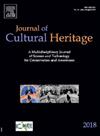测量帆布绘画支撑物和历史纺织品扭曲和卷曲的方法
IF 3.5
2区 综合性期刊
0 ARCHAEOLOGY
引用次数: 0
摘要
捻度和卷曲值对于纺织业了解纺织品的特性和性能至关重要,自 20 世纪初以来,量化捻度和卷曲值一直是一个研究课题。捻度和卷曲度是纤维如何从原始纤维束变形为纺织品的结果,因此用于测量它们的工业方法是基于机械地逆转这种变形。要研究历史织物(如帆布画支架和历史纺织品)的力学,也需要同样的信息,但这些信息更难获得,因为这些织物通常比较脆,浸渍了外来材料,不太均匀,而且取样非常有限。因此,这些基本参数通常无法用于保存研究。本文研究了纺织行业使用的规程,并提出了根据以往研究开发的新方法,用于可靠测量历史纺织品的捻度和卷曲度。捻度测量方法是非破坏性的,因为它基于对纺织品和纱线表面纤维的观察。卷曲是纱线交错的起伏,其测量需要观察单根纱线,因此是对纺织品内部结构的侵入性检查。这两种方法都适用于一组历史悠久的纺织品,提供的数据符合当前纺织业的参数,而且使用起来相对简单、成本低廉。本文章由计算机程序翻译,如有差异,请以英文原文为准。
Methodology for measures of twist and crimp in canvas paintings supports and historical textiles
Twist and crimp values are of paramount importance to the textile industry in understanding the properties and performance of a textile, and their quantification has been a subject of study since the early 20th century. Twist and crimp are the result of how the fibers have been modified from the original bundle to shape the textile, so the industrial methods used to measure them are based on mechanically reversing such deformations. The same information is needed to study the mechanics of historical fabrics such as canvas paintings supports and historical textiles, but they are more difficult to obtain because these are often brittle and impregnated with foreign materials, less homogeneous and very limited in availability for sampling. Therefore, such fundamental parameters are usually unavailable for conservation studies.
This paper examines the protocols used in the textile industry and proposes new methods, developed from previous research, for the reliable measurement of twist and crimp in historical textiles. The twist measurement method is non-destructive as it is based on observing the textile and the fibers on the surface of the yarn. Crimp is the undulation of the interlaced yarns and its measurement is an invasive examination of the internal structure of the textile, as it requires the observation of individual yarns. Both methods, applied here to a group of historical textiles, provide data in accordance with the current parameters of the textile industry, and their use is relatively simple and inexpensive.
求助全文
通过发布文献求助,成功后即可免费获取论文全文。
去求助
来源期刊

Journal of Cultural Heritage
综合性期刊-材料科学:综合
CiteScore
6.80
自引率
9.70%
发文量
166
审稿时长
52 days
期刊介绍:
The Journal of Cultural Heritage publishes original papers which comprise previously unpublished data and present innovative methods concerning all aspects of science and technology of cultural heritage as well as interpretation and theoretical issues related to preservation.
 求助内容:
求助内容: 应助结果提醒方式:
应助结果提醒方式:


